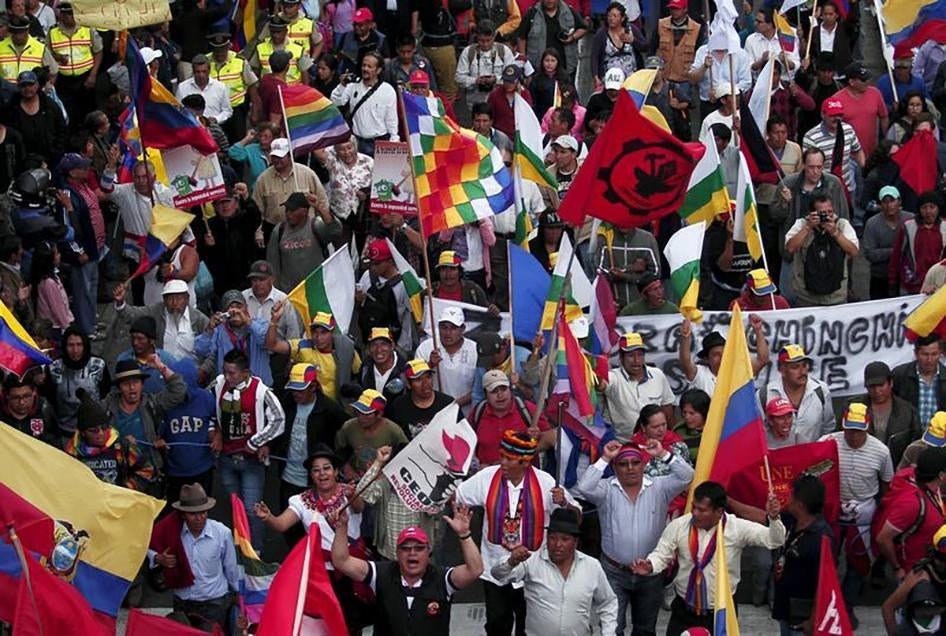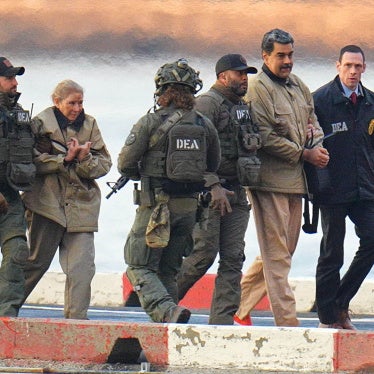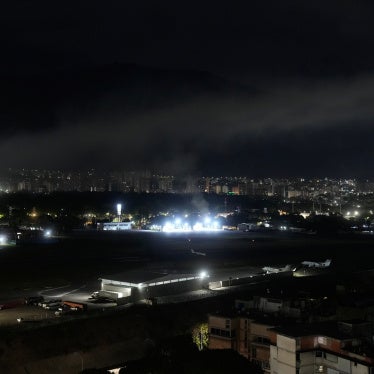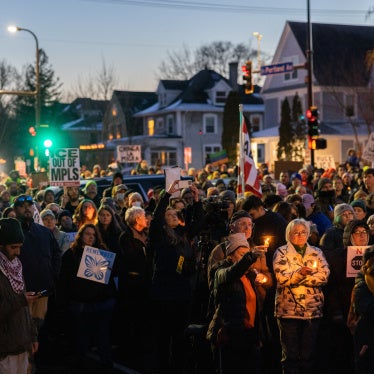The August Protests
The August demonstrations protested Correa administration proposals to amend the constitution to eliminate presidential term limits and allow the Armed Forces to participate in public security operations; rights violations associated with extractive industries projects; and government actions believed to threaten indigenous communities’ access to intercultural and bilingual education.
Witness accounts and video footage that Human Rights Watch reviewed show the protests to have been largely peaceful but also to have included sporadic clashes between security forces and civilians in which participants attacked security officers with sticks, rocks, spears, and Molotov cocktails. Human Rights Watch received conflicting accounts as to whether the attackers were demonstrators or provocateurs who had infiltrated the demonstrations.
The Official Account
Official news outlets repeated Correa’s accusations that the August protests were “violent” and reported that 116 police and military officers were injured during clashes and that 126 people were detained while allegedly committing such crimes as sabotage, paralyzing public services, and attacking security forces and public property.
The Interior Ministry reported on its website that indigenous groups in Saraguro, Loja province, kidnapped a police officer, a police commander, and a local politician during the afternoon of August 17. The commander and the politician were released several hours later, the ministry reported, while the police officer was taken to a building where members of an indigenous community forced him to kneel, covered his mouth with a cloth, threatened to burn and castrate him, and forced him to dress in indigenous women’s clothes. The government did not provide Human Rights Watch with information on any criminal investigation or prosecutions stemming from the alleged incident in the chart the government sent to Human Rights Watch.
Protests in Quito
On August 13, at least 50,000 people reportedly participated in a largely peaceful anti-government demonstration in the historic center of Quito. Video footage Human Rights Watch reviewed showed violent clashes between several demonstrators and members of the National Police, the agency charged with crowd control operations all over the country. Several demonstrators are seen throwing rocks, sticks, and Molotov cocktails at the police; or grabbing the metal bars, installed to limit where demonstrators could march, and throwing them toward the police, attempting to push them back.
According to the Confederation of Indigenous Nationalities of Ecuador (Confederación de Nacionalidades Indígenas del Ecuador, CONAIE), 35 people were detained in Quito that day. Human Rights Watch interviewed or reviewed videotaped testimony of several detained indigenous leaders, including Carlos Pérez Guartambel, president of the Kichwa Confederation of Ecuador (Confederación Kichwa del Ecuador, Ecuarunari); Salvador Quispe, the indigenous prefect of Zamora Chinchipe province; Katy Betancourt Machoa, CONAIE’s representative for women and family issues; and Liliana Herrera, daughter of CONAIE’s president.
All said that they had not been engaging in violent acts. Betancourt and Herrera told Human Rights Watch that they were beaten with batons as they were trying to help others who were being abused by the police. Those interviewed said that officers dragged them to a nearby street and forced them and several others to stay there, surrounded by police, for approximately three hours, finally releasing them with no explanation.
Manuela Picq, a French-Brazilian journalist and academic, told Human Rights Watch that she was detained when she was talking on the phone and demonstrating peacefully with Guartambel, her partner. A group of officers went toward the demonstration where she was standing, and kicked her and beat her with their fists or batons, Picq said. According to video footage filmed by a witness, the officers appear to grab and attack Picq with no prior motive. Picq’s detention report says that she was arrested because she did not have legal status to remain in the country, but official documentation Human Rights Watch reviewed shows that she had a valid visa, which was cancelled a day after her arrest. In addition, Human Rights Watch reviewed medical records corroborating her injuries.
Picq was held in a detention center in Quito for immigrants without legal status until August 17, when a judge refused to issue a deportation order. On August 21, after the government appealed the decision to the Interior Ministry, which under Ecuadorian law can overturn deportation rulings, and after another judge denied an injuction to uphold her visa, Picq left the country to avoid further proceedings. She requested a new visa to return to Ecuador, but it was denied, her lawyer told Human Rights Watch.
Twenty-two of the 35 people detained in Quito on August 13 were taken before a judge and charged with “attacking or resisting with violence or threats” the actions of public officials, including police officers, a lawyer working for CONAIE told Human Rights Watch. The law carries a sentence of up to two years, which may increase to three years if committed “by many people and as a consequence of a previous agreement.”
Among those detained was Paul Renato Carrasco Procel, a 26-year-old student, who at about 7 p.m. joined other protesters trying to stop a man who hit a police officer’s horse. A police officer grabbed him from behind, threw him to the ground, and kicked him, he told prosecutors. Another officer beat him with a police baton and dragged him behind a line of police officers, holding him there.
At about the same time, police detained Wilson Rodrigo Loachamin Fernández, a 44-year-old farmer who was sitting near a monument in the Plaza Santo Domingo in the historic center. Loachamin had participated in the demonstration earlier that day and was waiting for it to disperse so he could go home, he told prosecutors. When he saw police officers on motorcycles circling the monument, Loachamin decided to leave the area, but tripped and fell. The policemen beat and kicked him as he lay on the ground. They forced him onto a motorcycle between two policemen, who continued to beat him.
Police took Carrasco and Loachamin, along with Mosquera – the merchant who was beaten when he intervened to assist another victim of a police beating – to the Interior Ministry and then to a hospital, they told prosecutors. Official medical reports dated August 14 say the three men showed “recent” injuries and bruises.
On the night of August 14, the three men appeared before a judge, who ordered their pretrial detention. Statements provided by police officers to the Attorney General’s Office, which are included in the judicial file and were reviewed by Human Rights Watch, describe violent incidents in the area where the three were arrested but do not identify any of the detainees by name. Four of the police statements – which are labeled as having been made before the same prosecutor on August 14 between 4:40 and 4:49 a.m. – are verbatim copies of one another, including the same typos.
Protests in Saraguro
During the morning of August 17, military and police personnel used excessive force to disperse a largely peaceful anti-government protest by members of an indigenous community in Saraguro, Loja province. These incidents occurred hours before the alleged kidnap of a police officer reported by the Interior Ministry.
A series of videos taken by local residents – and provided to Human Rights Watch by Adriana Camacho Echeverri, an independent researcher who visited the area days after the incidents – show a large contingent of security forces walking toward a group of protesters who are peacefully blocking a main road. The officers are seen throwing teargas grenades at demonstrators to disperse them, then pursuing those who fled. Other images show teargas grenades hitting nearby homes – in one case landing on a roof – and officers entering a home attempting to detain someone.
The Ecuadorian Ecumenical Human Rights Commission (Comisión Ecuménica de Derechos Humanos, CEDHU), a human rights group, said that security forces entered homes in the area without warrants or any evidence of crimes, and that they threw teargas grenades into homes where there were children. Security forces beat people in their homes with batons and illegally detained some of them, CEDHU said in an amicus brief filed to request the immediate release of those detained in Saraguro on August 17.
Human Rights Watch reviewed taped or written accounts from more than 45 victims and residents taken by Echeverri and another researcher collaborating with CONAIE who visited Saraguro in August. The accounts are consistent with the CEDHU account. The names of some victims are withheld to protect their identities.
In one case, Manuel Asunción Poma Poma, 47, said that about 10 police officers detained him when he was leaving a store near where officers had attempted to disperse a demonstration, beat him with their batons, and forced him into a police car. The officers told Poma he was under detention and then dropped him off at a hospital because he was bleeding profusely.
A medical report dated September 8 says Poma suffered a “blunt blow” to his lower jaw that caused him to lose five teeth and part of his jaw. The dentist who treated him said during a taped interview with researchers that the blow had to be “extremely strong” to cause such an injury and provided an X-ray of Poma’s mouth, showing the missing teeth.
Gabriel Antonio Paqui Andrade, 25, said a teargas grenade hit him in the eye when he left his house to defend women who were being attacked by police officers. In one of the videotaped interviews, his partner, who witnessed the incident, said that security forces shot teargas grenades directly at people from a distance of about 20 meters. Human Rights Watch reviewed pictures of Paqui’s injured eye. A medical report by the Public Health Ministry dated August 24 confirms a diagnosis of “ocular trauma” in Paqui’s left eye, which kept him hospitalized for several days.
Rosa (pseudonym), 75, told the researchers she was at home cooking when teargas started to fill the rooms. Several police officers burst in, kicked her, and grabbed her by the arms, and hit her with a police baton in her stomach, she said. Others threw her grandson into the mud outside her home and pulled her husband’s hair, and pushed him at a mirror, breaking it.
Juan (pseudonym), 15, was cooking, he and his father said, when military officers kicked open the door to their home and forcefully dragged Juan away. They held him overnight, then released him.
María (pseudonym) reported that an officer shouted, “Grab that Indian woman!” before police and military officers seized her and hit her with a rock.
In the days following the Saraguro protest on August 17, 38 people were brought before a judge and accused of “paralyzing public services,” according to the Attorney General’s Office.
During a hearing on August 22 to determine the legality of the detention of 27 of the 38 detainees, most said that they had been arbitrarily detained while they were inside a house or when they were attempting to defend others who were being physically assaulted by security forces, according to an unofficial summary of the testimony before the judge that was shared with Human Rights Watch. The summary notes not only that most of the detainees were beaten with fists or batons but also that several detained women were threatened with rape. The court, however, rejected a habeas corpus request for the Saraguro detainees’ release.
One of the detained women said in a taped interview that she tried to stop police from beating a pregnant woman, but the officers pushed her away using their shields and said the same would happen to her if she didn’t leave. Two policemen forcefully grabbed her by the arms, leaving marks, and detained her. “Shut up, Indians!” the woman said the police shouted, and “Grab them by their braids!”
Most of the people detained in Saraguro remain subject to criminal prosecution, including four who are in pretrial detention, according to the Attorney General’s Office.
Other Allegations of Abuse
Human Rights Watch received credible reports that security forces used unlawful force or arbitrarily detained people in other locations as well, including:
- Margoth Escobar, 61, an environmental and indigenous rights activist, said she was detained on August 13 in Puyo, Pastaza province, while standing on the street as a protest ended. Escobar told the Inter-American Commission on Human Rights on October 19 that officers beat and kicked her and threatened to shoot teargas into her mouth because she was “demanding the protection of her rights.” Human Rights Watch reviewed a picture that shows bruises on her body. Escobar said she was charged with “attack or resistance” against authorities and was held in pretrial detention until August 21, when she was released on the condition that she regularly check in with the courts;
- Margarita Sánchez de Atacama, 26, said in a taped news conference that as she was leaving her home in Otavalo on August 20 she noticed that security agents were blocking a major road and, as she watched the officers disperse, one of them approached her and without warning shot some kind of weapon at her from a distance of two meters. Sánchez was hit on her left hand and legs and wore a bandage covering her injured left hand;
- Luis Hernán Pallasco Vega lost his eye, CONAIE reported, after a teargas grenade hit him when security forces were dispersing a demonstration on August 15 in El Chasqui, Cotopaxi; and
- Eight people were detained by members of the military on August 18 in Loreto, Orellana province, and charged with “sabotage” for allegedly interfering with petroleum extraction by the state-owned company Petroamazonas. A local group, the Orellana Permanent Committee to Defend Human Rights (Comité Permanente de Defensa de los Derechos Humanos de Orellana) provided information on the case. Although there had been a demonstration near the Petroamazonas plant, no one was detained there, and the eight people had not been participating in the protest, they told a lawyer who interviewed them while in detention.
In August, a coalition of Ecuadorian organizations reported that during the protests, 142 people were detained, 77 others were subjected to abuse, and several homes were illegally searched. The report’s authors told Human Rights Watch that their findings were based on accounts from victims or witnesses, medical records, and photographs, including some that were published in the report. The report includes transcripts of several accounts by victims of alleged beatings and arbitrary detention, some of which may be the same cases documented by Human Rights Watch. The report uses initials to identify some victims. Human Rights Watch has not been able to corroborate all of the allegations, but the Ecuadorian justice system should effectively investigate all credible allegations of abuse described in the report.
Accountability
Ecuador is obliged under international law to carry out effective investigations into allegations of abuse. The Ecuadorian Constitution and Organic Integral Criminal Code empower prosecutors, when there is evidence that a crime was committed, to open criminal investigations even if the victim does not file a formal complaint.
After Human Rights Watch made its October 13 request to the attorney general for information on the status of investigations into attacks by and against security forces, the attorney general on October 14 emailed Human Rights Watch a copy of a book prepared by the Attorney General’s Office on social protests in Ecuador that does not include information on the August 2015 protests.
On October 27, the Attorney General’s Office provided Human Rights Watch with the chart that included brief descriptions and status updates on 130 cases opened against demonstrators. In the vast majority of cases, detainees were accused of attacking the police with sticks and rocks, allegedly based on police reports, video images of violent clashes with the police, and medical reports of injuries suffered by the police. The Attorney General’s Office did not provide Human Rights Watch with copies of the evidence it says it has.
While it is appropriate to pursue charges against protesters who committed crimes, fully respecting their due process and fair trial rights, the chart does not include any information on investigations against police or military officers accused of committing abuses during the August protests.









